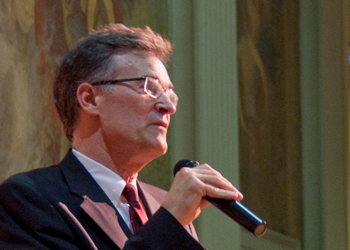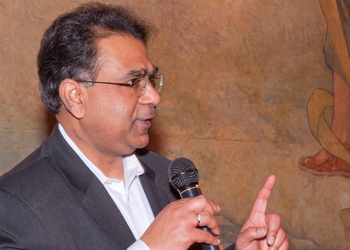The Ragon Institute celebrated three years of innovation and excellence on March 2, 2012. All Ragon Institute faculty and staff and their families and guests, collaborators from multiple continents, as well as donors Terry and Susan Ragon and their family, gathered at Walker Memorial on the MIT campus to mark this anniversary.
 In his opening remarks, Ragon Institute Director, Dr. Bruce Walker recalled that, after three decades of failure, many in the AIDS research community felt it was time to take a new approach, to bring disciplines together, and to bring existing tools to bear on the problem of finding a vaccine for AIDS. It was the generosity of the Ragons which established the Ragon Institute three years ago, giving scientists the ability to be flexible and innovative and rapidly move the most important research forward. He called the past the years of the Ragon Institute an “exhilarating” time, breaking down boundaries, bringing people together, and applying new ideas and techniques to the research and really making advances.
In his opening remarks, Ragon Institute Director, Dr. Bruce Walker recalled that, after three decades of failure, many in the AIDS research community felt it was time to take a new approach, to bring disciplines together, and to bring existing tools to bear on the problem of finding a vaccine for AIDS. It was the generosity of the Ragons which established the Ragon Institute three years ago, giving scientists the ability to be flexible and innovative and rapidly move the most important research forward. He called the past the years of the Ragon Institute an “exhilarating” time, breaking down boundaries, bringing people together, and applying new ideas and techniques to the research and really making advances.
As an example of some of those advances, Dr. Walker highlighted the work of Dan Barouch who has developed an AIDS vaccine that has provided the best protection yet in an animal model of AIDS infection. Also, the work of Jack Mao and Joe Sodroski’s novel cryo-EM methods have provided the first detailed view of what the virus actually looks like and how we need to make antibodies against it. Finally, the work of Galit Alter and Marcus Altfeld has shown that an additional arm of the immune system is critical to controlling infection thereby has providing a new approach to moving forward.
Dr. Walker called the progress “impressive” but cautioned that there is still a long way to go. During a recent trip to South Africa, he observed that the funding for treatment is tightening up and the situation is getting worse, not better, with ever more people in need of the AIDS drug cocktail. He was more convinced than ever that the only possible solution to this epidemic is the development of an effective vaccine and he expressed optimism saying, “we believe this is an achievable goal.”

Another exciting milestone for Ragon will be the move to a new research facility at Tech Center on the MIT campus, scheduled for January 2013. There, the Ragon Institute will be embedded with physical scientists, engineers and computational biologists from MIT, thereby increasing the number of potential collaborations and the depth of research.
Dr. Walker concluded by reminding everyone that while there is an enormous need for support for those suffering with AIDS around the world, people right here in Boston are living with AIDS and many lack essential services. For the past 10 years, the Ragon Institute (and its former iteration Partners AIDS Research Center) has been partnered with the Boston-based AIDS Action Committee and they have done a “stellar job” in providing these services. Last year the Ragon Institute was the second largest fundraiser for AIDS Walk Boston and Dr. Walker encouraged everyone to double their fund-raising efforts this year in order to take first!

Dr. Dan Barouch spoke next on what a great three years of collaboration with the Ragon Institute has meant for him and for his lab at Harvard. He noted that Ragon has funded a huge amount of incredible research that would not have been otherwise funded. Even more than that, Ragon has created a community of investigators not only at Harvard, MIT and MGH but around the world and with this collaboration, the future is bright.
“There is much more work to do,” he noted, “but we are more optimistic now than ever before that an AIDS vaccine is actually possible.”

Dr. Arup Chakraborty thanked Terry and Susan Ragon for their support and observed that they did not just provide funding. Rather the Ragons understood something many did not which is that by thinking about a specific problem or application, such as building an AIDS vaccine, it can “focus ones mind to confront and overcome the biggest of challenges. Not only that, but by solving the initial problem, you build a conceptual framework that allows you to solve the problems of the world.”
The Ragon 3rd Anniversary was a time to celebrate the momentum gained in the last three years. As Dr. Walker observed, “We’ve made progress and we should never forget that there is an enormous and critical need to what we’re doing.”
View a gallery of images of the event
- Drs Walker, Chakraborty and Barouch with Terry and Susan Ragon
- Dr. Dan Barouch
- Drs. Bruce Walker and Dan Barouch
- Susan and Terry Ragon
- Arup Chakraborty and family
- Dr. Galit Alter and twin daughters
- Dr. Zaza Ndhlovu and family
- Dr. Todd Allen and Jessica
- Kathleen Donnelly, Ken Mayer and Terry Ragon
- Salim Karim
- Dr. Marylyn Addo, Marcus Altfeld and daughter
- Jessica O’Leary, Dr. Todd Allen and Dr. Mary Carrington
- Dr. Daniel Kaufmann and daughter


 Ragon Institute
Ragon Institute 




















